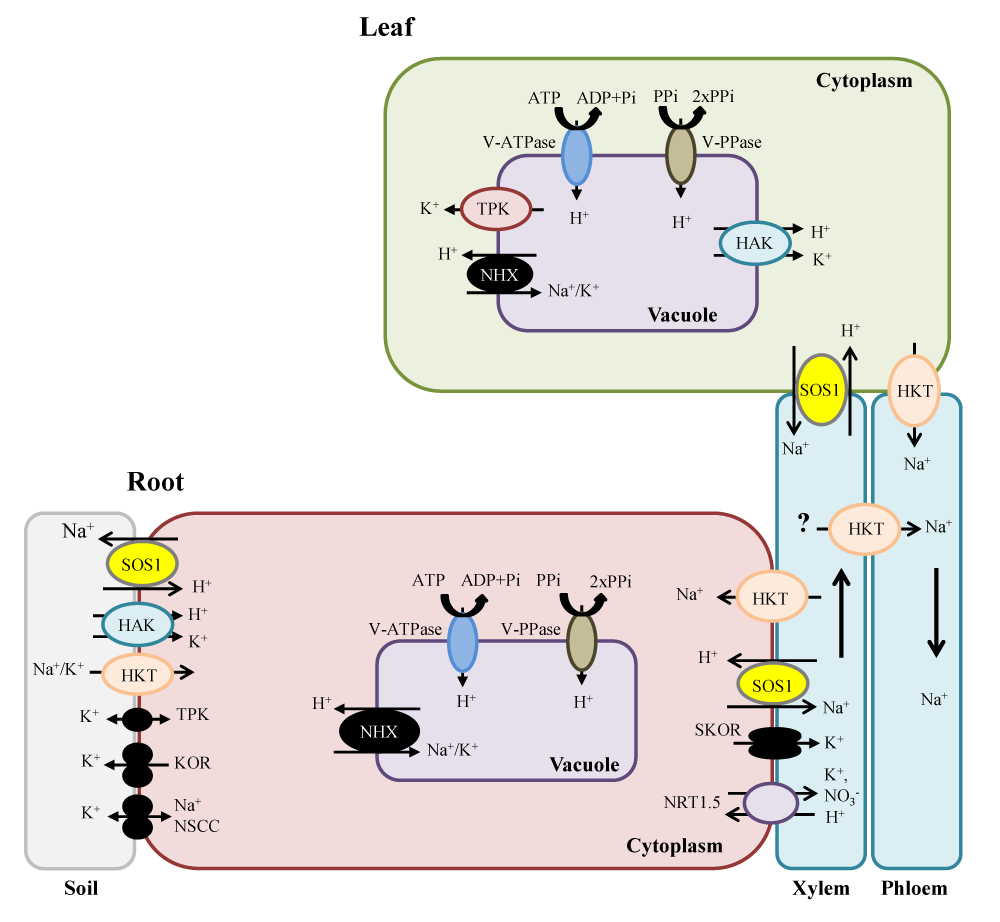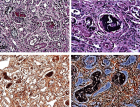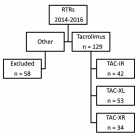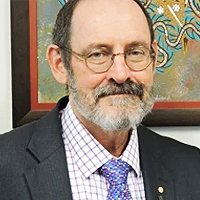Figure 2
Ion transporters and their molecular regulation mechanism in plants
Faiçal Brini* and Walid Saibi
Published: 25 May, 2021 | Volume 5 - Issue 2 | Pages: 028-043

Figure 2:
Schematic representation showing key plasma and tonoplast membrane transporters, channels and pumps mediating Na+ and K+ homeostasis in plants under salt stress. Na+ ions enter the cells via Non-Selective Cation Channels (NSCCs) and possibly via other cation transporters (symplast flow) and through the cell wall and intercellular spaces (apoplast flow). The Na+/H+ antiporter SOS1 extrudes Na+ at the root soil interface, thus reducing the Na+ net influx of Na+. At the xylem parenchyma cells, HKT1-like proteins retrieve Na+ from the xylem sap, thereby restricting the amount of Na+ reaching the photosynthetic tissues. To translocate Na+ back to the root, ions unloaded from xylem may be transported into phloem via additional HKT1-like protein. In addition, HKT1-like proteins also load Na+ into shoot phloem, and then Na+ is transferred into roots via phloem, preventing Na+ accumulation in shoots. SOS1, localized in the xylem parenchyma cells, is also suggested to mediate Na+ efflux from xylem vessels under high salinity. Incoming Na+, in root and shoots, is stored in the large central vacuole by tonoplast-localized NHX exchangers. Plasma membrane (PM) H+-ATPase (P-ATPase), PM H+-PPase (PM-PPase), tonoplast H+-ATPase (V-ATPase) and tonoplast H+-PPase (V-PPase) generate electrochemical potential gradient for secondary active transport.
Read Full Article HTML DOI: 10.29328/journal.jpsp.1001058 Cite this Article Read Full Article PDF
More Images
Similar Articles
-
Bacillus amyloliquefaciens as a plant growth promoting bacteria with the interaction with of grass salt Distichlis palmeri (Vasey) under field conditions, in desert of Sonora, MexicoRueda Puente Edgar O*,Ruiz Alvarado Cristina,Jesús Borboa Flores,Victor Cardenas Salazar,Soto Ortiz Roberto,Lourdes Díaz Cervantes. Bacillus amyloliquefaciens as a plant growth promoting bacteria with the interaction with of grass salt Distichlis palmeri (Vasey) under field conditions, in desert of Sonora, Mexico. . 2018 doi: 10.29328/journal.jpsp.1001021; 2: 059-067
-
Ion transporters and their molecular regulation mechanism in plantsFaiçal Brini*,Walid Saibi. Ion transporters and their molecular regulation mechanism in plants. . 2021 doi: 10.29328/journal.jpsp.1001058; 5: 028-043
-
Impact of Biofertilizers & Different doses of NPK on Growth and Photosynthetic Pigments of Okra Plant (Abelmoschus Esculentus L. Moench)Reena Kujur*, Heba I Khan, Eugenia P Lal, Lalit Kumar Verma. Impact of Biofertilizers & Different doses of NPK on Growth and Photosynthetic Pigments of Okra Plant (Abelmoschus Esculentus L. Moench). . 2023 doi: 10.29328/journal.jpsp.1001112; 7: 092-096
Recently Viewed
-
Assessment and Correlation of Serum Urea and Creatinine Levels in Normal, Hypertensive, and Diabetic Persons in Auchi, NigeriaAkpotaire PA, Seriki SA*. Assessment and Correlation of Serum Urea and Creatinine Levels in Normal, Hypertensive, and Diabetic Persons in Auchi, Nigeria. Arch Pathol Clin Res. 2023: doi: 10.29328/journal.apcr.1001035; 7: 007-016
-
Successful Treatment of Generalized Pustular Psoriasis during Pregnancy by Cyclosporin and Etanercept: Own Experience and Review of LiteratureRauno J Harvima*, Ilkka T Harvima. Successful Treatment of Generalized Pustular Psoriasis during Pregnancy by Cyclosporin and Etanercept: Own Experience and Review of Literature. Ann Dermatol Res. 2024: doi: 10.29328/journal.adr.1001032; 8: 007-011
-
The Accuracy of pHH3 in Meningioma Grading: A Single Institution StudyMansouri Nada1, Yaiche Rahma*, Takout Khouloud, Gargouri Faten, Tlili Karima, Rachdi Mohamed Amine, Ammar Hichem, Yedeas Dahmani, Radhouane Khaled, Chkili Ridha, Msakni Issam, Laabidi Besma. The Accuracy of pHH3 in Meningioma Grading: A Single Institution Study. Arch Pathol Clin Res. 2024: doi: 10.29328/journal.apcr.1001041; 8: 006-011
-
New Fungi Associated with Blackberry Root Rot (Rubus spp.), in Michoacán, MexicoLuis Mario Tapias Vargas, Anselmo Hernández Pérez, Adelaida Stephany Hernández Valencia*. New Fungi Associated with Blackberry Root Rot (Rubus spp.), in Michoacán, Mexico. J Plant Sci Phytopathol. 2024: doi: 10.29328/journal.jpsp.1001129; 8: 038-040
-
Auxin-like and Cytokinin-like Effects of New Synthetic Pyrimidine Derivatives on the Growth and Photosynthesis of WheatTsygankova Victoria Anatolyivna*, Andrusevich YaV, Vasylenko NM, Kopich VM, Popilnichenko SV, Pilyo SG, Brovarets VS. Auxin-like and Cytokinin-like Effects of New Synthetic Pyrimidine Derivatives on the Growth and Photosynthesis of Wheat. J Plant Sci Phytopathol. 2024: doi: 10.29328/journal.jpsp.1001126; 8: 015-024
Most Viewed
-
Evaluation of Biostimulants Based on Recovered Protein Hydrolysates from Animal By-products as Plant Growth EnhancersH Pérez-Aguilar*, M Lacruz-Asaro, F Arán-Ais. Evaluation of Biostimulants Based on Recovered Protein Hydrolysates from Animal By-products as Plant Growth Enhancers. J Plant Sci Phytopathol. 2023 doi: 10.29328/journal.jpsp.1001104; 7: 042-047
-
Feasibility study of magnetic sensing for detecting single-neuron action potentialsDenis Tonini,Kai Wu,Renata Saha,Jian-Ping Wang*. Feasibility study of magnetic sensing for detecting single-neuron action potentials. Ann Biomed Sci Eng. 2022 doi: 10.29328/journal.abse.1001018; 6: 019-029
-
Physical activity can change the physiological and psychological circumstances during COVID-19 pandemic: A narrative reviewKhashayar Maroufi*. Physical activity can change the physiological and psychological circumstances during COVID-19 pandemic: A narrative review. J Sports Med Ther. 2021 doi: 10.29328/journal.jsmt.1001051; 6: 001-007
-
Pediatric Dysgerminoma: Unveiling a Rare Ovarian TumorFaten Limaiem*, Khalil Saffar, Ahmed Halouani. Pediatric Dysgerminoma: Unveiling a Rare Ovarian Tumor. Arch Case Rep. 2024 doi: 10.29328/journal.acr.1001087; 8: 010-013
-
Prospective Coronavirus Liver Effects: Available KnowledgeAvishek Mandal*. Prospective Coronavirus Liver Effects: Available Knowledge. Ann Clin Gastroenterol Hepatol. 2023 doi: 10.29328/journal.acgh.1001039; 7: 001-010

HSPI: We're glad you're here. Please click "create a new Query" if you are a new visitor to our website and need further information from us.
If you are already a member of our network and need to keep track of any developments regarding a question you have already submitted, click "take me to my Query."

























































































































































